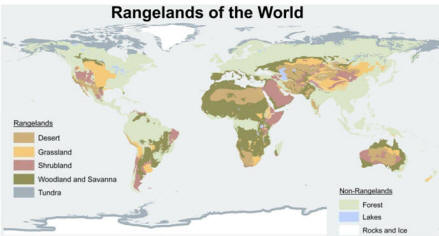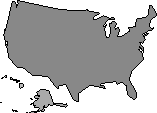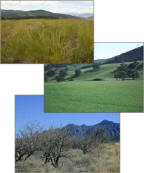 |
Detailed Definitions:
"Land on which the vegetation is predominantly grasses, grass-like
plants, forbs, or shrubs. Rangelands include natural grasslands,
shrublands, woodlands, savannahs, tundra, most deserts, and riparian
and wetland plant communities including marshes and wet meadows.
Includes lands revegetated naturally or artificially that are
managed like native vegetation."
Western
Rangelands Partnership 2007)
"Areas dominated
by self-propagating vegetation comprised predominantly of grasses,
grass-likes, forbs, shrubs, and dispersed trees."
(Sustainable
Rangeland Roundtable) |
What Kinds of Land are Rangeland?
| Rangelands are called by many
different names around the world. These diverse and
complex landscapes are recognized as several distinctive
biomes including Grasslands,
Shrublands,
Woodlands, and
Deserts. |
| Grasslands
are ecosystems that are dominated by grasses. In the
world, grassland biomass go by many names including prairie,
steppe, pampas, swards, meadows and velds. In North America,
grassland biomes include the Tallgrass Prairie,
Shortgrass Prairie, Alpine Meadows, California Annual
Grasslands, Palouse Prairie, Southern Mixed
Prairie, Marshes, Wet Meadows,
Tundra Grasslands, and Desert Grasslands.
|
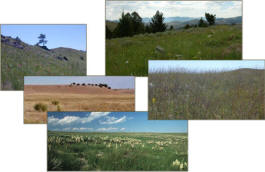 |
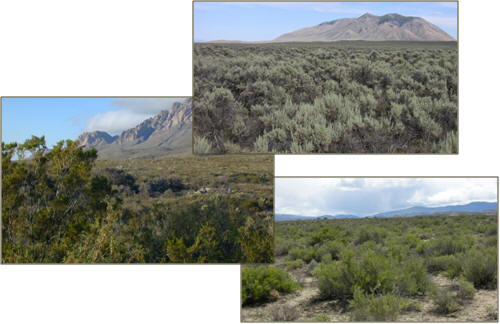 |
Shrublands are lands with abundant stands of shrubs
with an understory of grasses and herbaceous plants, but shrubs dominate these ecosystems. Shrublands
across the world are called chaparral, cerrados,
shrub-steppe, maquis, and scrublands. In North America,
shrubland biomes include Chaparral,
Sagebrush-steppe, Salt-desert Shrublands,Tundra
Shrublands, and Mountain Browse. |
| Woodlands
and Savannas
are dominated by widely-spaced trees including junipers,
oaks, mesquite and pines with an understory of grasses and
forbs. Woodland ecosystems across the world take the
names of the trees that dominate the landscape. In North
America, the largest woodland biome is the Pinyon-Juniper
Woodland. Other woodland and savanna ecosystems
include Oak Woodlands, Aspen Savannas, and
Mesquite Woodlands. |
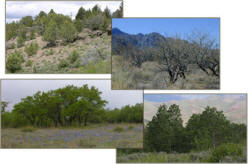 |
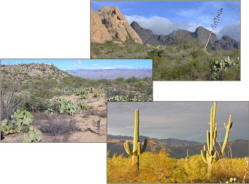 |
Deserts
are the driest rangelands and they experience extreme water
shortage and unpredictable precipitation. These ecosystems
are dominated by shrubs and succulent cactus plants. Deserts
and arid lands in the world cover massive areas and include
the Saharan, Namib, Arabian, Atacama, Australian Outback,
and Kalahari deserts. The Hot desert biomes in the North
America are found in the southwest and include the Mojave,
Sonoran, and Chihuahuan deserts. |
| Rangeland Are..... |
| ...grasslands,
woodlands, steppes, savannas, shrublands, meadows,
prairies, and most deserts |
are not.. forests,
ice, snow, or shifting sand |
| ...wild
and natural |
are not.. urban or
suburban areas farm fields |
| ...areas
with a climate that favors grasses, forbs, shrubs, and a few
trees |
are not.. barren
deserts or dense forests |
| ...used
for recreation, wildlife habitat, livestock production,
watersheds, and wind & solar power |
are not.. cultivated
to grow crops or harvested for timber |
| ...forage
resources harvested by wildlife and livestock |
are not.. harvested
with machines |
| ...managed
by ecological principles |
are not.. managed by
agronomic or forestry principles |
| ...“wild
open spaces” for all to enjoy |
are not.. busy, noisy,
crowded, or boring |
What are Rangelands Used For?
| |
Rangelands produce a wide variety of
goods and services desired by society, including livestock
forage, wildlife habitat, water, mineral resources, wood
products, wildland recreation, open space and natural
beauty. The geographic extent and many important resources
of rangelands make their proper use and management vitally
important to people everywhere. |
How Much Rangeland is There?
Who Manages Rangeland?
Rangelands are varied and complex systems that produce a myriad of
valuable goods and services. Many different types of natural
resources managers and practitioners work together, using
techniques based on ecological principles, to assure that these
areas are managed sustainably.
People involved in managing these lands include range managers,
plant ecologists, wildlife and livestock managers, soil scientists,
and recreation specialists.
Range managers themselves are often wear many hats, uniting the
different disciplines and interacting with many users and
stakeholders to ensure that sound environmental stewardship is
practiced. Managing these ‘wild open spaces’ is
challenging but rewarding work in some of the most beautiful ‘offices’
in the world.
|
Rangelands ... worth
writing about.
"I would be converted to a
religion of grass. Sleep the winter away and rise headlong
each spring. Sink deep roots. Conserve water. Respect and
nourish your neighbors and never let trees gain the upper
hand…Bow beneath the arm of fire. Connect underground.
Provide. Provide. Be lovely and do no harm."
--Louise Erdrich, "Big Grass", Heart of the Land
"[C]rossing...the
98th meridian...the air became humid...and the landscape
turned distressingly green. The Eastern United States...was
badly infested by plants." -- Patricia Nelson
Limerick,
Something in the Soil
“…for that wind that made one a boy
again...that lightness, that dry aromatic odor...one could
breathe that only on the bright edges of the world, on the
great grass plains or the sagebrush desert.” --
Willa Cather,
Death Comes for the Archbishop |
|






